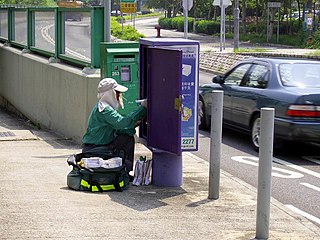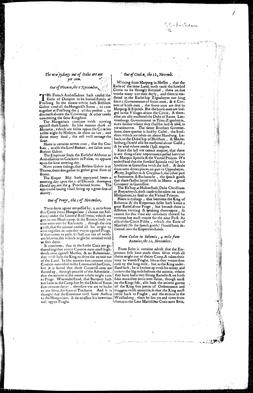
A letter is a written message conveyed from one person to another through a medium. Something epistolary means that it is a form of letter writing. The term usually excludes written material intended to be read in its original form by large numbers of people, such as newspapers and placards, although even these may include material in the form of an "open letter". The typical form of a letter for many centuries, and the archetypal concept even today, is a sheet of paper that is sent to a correspondent through a postal system. A letter can be formal or informal, depending on its audience and purpose. Besides being a means of communication and a store of information, letter writing has played a role in the reproduction of writing as an art throughout history. Letters have been sent since antiquity and are mentioned in the Iliad. Historians Herodotus and Thucydides mention and use letters in their writings.

Philately is the study of postage stamps and postal history. It also refers to the collection and appreciation of stamps and other philatelic products. Philately involves more than just stamp collecting or the study of postage; it is possible to be a philatelist without owning any stamps. For instance, the stamps being studied may be very rare or reside only in museums.

A postage stamp is a small piece of paper issued by a post office, postal administration, or other authorized vendors to customers who pay postage. Then the stamp is affixed to the face or address-side of any item of mail—an envelope or other postal cover —which they wish to send. The item is then processed by the postal system, where a postmark or cancellation mark—in modern usage indicating date and point of origin of mailing—is applied to the stamp and its left and right sides to prevent its reuse. Next the item is delivered to its addressee.

A tabloid is a newspaper with a compact page size smaller than broadsheet. There is no standard size for this newspaper format.

The mail or post is a system for physically transporting postcards, letters, and parcels. A postal service can be private or public, though many governments place restrictions on private systems. Since the mid-19th century, national postal systems have generally been established as a government monopoly, with a fee on the article prepaid. Proof of payment is usually in the form of an adhesive postage stamp, but a postage meter is also used for bulk mailing.

A broadsheet is the largest newspaper format and is characterized by long vertical pages, typically of 22.5 inches (57 cm). Other common newspaper formats include the smaller Berliner and tabloid–compact formats.

Postal history is the study of postal systems and how they operate and, or, the study of the use of postage stamps and covers and associated postal artifacts illustrating historical episodes in the development of postal systems. The term is attributed to Robson Lowe, a professional philatelist, stamp dealer and stamp auctioneer, who made the first organised study of the subject in the 1930s and described philatelists as "students of science", but postal historians as "students of humanity". More precisely, philatelists describe postal history as the study of rates, routes, markings, and means.

The French post offices in Egypt were a system of post offices maintained by France in Egypt during the 19th century and the early years of the 20th century. They were primarily intended to facilitate commercial and trading interests that needed to communicate between France and points east.

Berliner is a newspaper format with pages normally measuring about 315 by 470 millimetres. The Berliner format, or "midi", is slightly taller and marginally wider than the tabloid/compact format, and is both narrower and shorter than the broadsheet format.

A letter to the editor (LTE) is a letter sent to a publication about an issue of concern to the reader. Usually, such letters are intended for publication. In many publications, letters to the editor may be sent either through conventional mail or electronic mail.

Operation Cornflakes was a morale operation by the Office of Strategic Services during World War II that aimed to trick Deutsche Reichspost into inadvertently delivering anti-Nazi propaganda to German citizens through mail.
A weekly newspaper is a general-news or current affairs publication that is issued once or twice a week in a wide variety broadsheet, magazine, and digital formats. Similarly, a biweekly newspaper is published once every two weeks. Weekly newspapers tend to have smaller circulations than daily newspapers, and often cover smaller territories, such as one or more smaller towns, a rural county, or a few neighborhoods in a large city. Frequently, weeklies cover local news and engage in community journalism.

A broadside is a large sheet of paper printed on one side only. Historically in Europe, broadsides were used as posters, announcing events or proclamations, giving political views, commentary in the form of ballads, or simply advertisements. In Japan, Chromoxylographic broadsheets featuring artistic prints were common.

Tabloid journalism is a popular style of largely sensationalist journalism which takes its name from the tabloid newspaper format: a small-sized newspaper also known as half broadsheet. The size became associated with sensationalism, and tabloid journalism replaced the earlier label of yellow journalism and scandal sheets. Not all newspapers associated with tabloid journalism are tabloid size, and not all tabloid-size newspapers engage in tabloid journalism; in particular, since around the year 2000 many broadsheet newspapers converted to the more compact tabloid format.
Pakistan Post is a state enterprise which functions as Pakistan's primary and largest postal operator. 49,502 employees through a vehicle fleet of 5,000 operate traditional "to the door" service from more than 13,419 post offices across the country, servicing over 50 million people. Pakistan Post operates under the autonomous "Postal Services Management Board" to deliver a full range of delivery, logistics and fulfillment services to customers.
The Falkirk Herald is a weekly newspaper and daily news website published by National World. It provides reportage, opinion and analysis of news, current affairs and sport in the towns of Falkirk, Grangemouth, Larbert, Stenhousemuir and Denny as well as the neighbouring villages of Polmont, Redding, Brightons, Banknock and Bonnybridge. Its circulation area has a total population of 151,600, the fifth largest urban area in Scotland. It was named Weekly Newspaper of the Year at the 2013 Scottish Press Awards.

Gerard Unger was a Dutch graphic and type designer. He studied at the Gerrit Rietveld Academie in Amsterdam from 1963 to 1967, and subsequently worked at Total Design, Prad and Joh. Enschedé. In 1975, he established himself as an independent developer. A long-time guest lecturer at the University of Reading, he mentored many modern typeface designers. He lived and worked in Bussum, Netherlands.

Newsbooks were the 17th-century precursors to today's newspapers. Originating in England and Scotland, they are distinct from the earlier news periodicals, known as corantos, which were sourced from continental Europe.

A mass sighting of celestial phenomena or unidentified flying objects (UFO) occurred in 1561 above Nuremberg. This view is mostly dismissed by skeptics, some referencing Carl Jung's mid-twentieth century writings about the subject; others feel that the phenomenon was likely to have been a sun dog.
The history of journalism in the United Kingdom includes the gathering and transmitting of news, spans the growth of technology and trade, marked by the advent of specialised techniques for gathering and disseminating information on a regular basis. In the analysis of historians, it involves the steady increase of the scope of news available to us and the speed with which it is transmitted.














